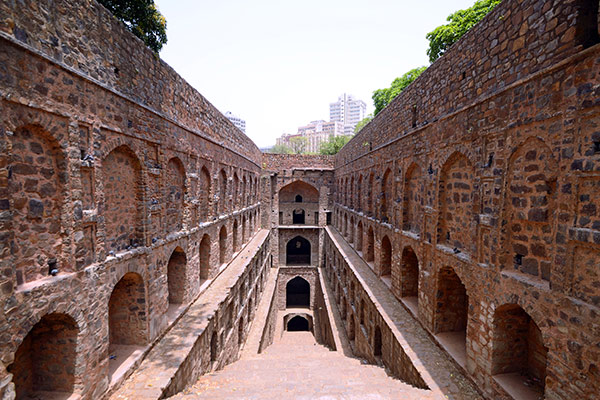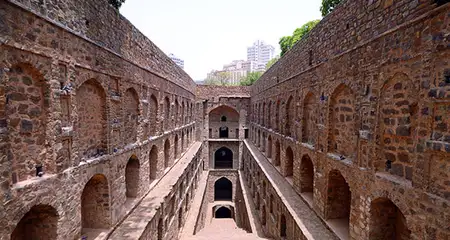Agrasen ki Baoli aka Ugrasen ki Baoli stands in the heart of Delhi as a souvenir left behind by time. This ornate stepwell, which was once a water reservoir, is an exquisite example of splendid architecture and ancient engineering skills. One of the oldest monuments and the best-preserved stepwell in Delhi, it now serves as a prime attraction for tourists and photography enthusiasts visiting the national capital. Its silent walls, forlorn steps, and stone arches narrate the tale of its erstwhile grandeur and glory. Agrasen ki Baoli is definitely one of those heritage structures you must explore when you step out of your hotels in Delhi for a sightseeing spree.
Want to know more about this historical stepwell in Delhi? Here is everything you should know about Agrasen ki Baoli in Delhi, including its history, timings, entry fee, and other interesting details.
Agrasen ki Baoli Information:
| Location | Hailey Road, New Delhi |
| Type | Stepwell |
| Also Known as | Ugrasen ki Baoli |
| Timings | 7:00 am to 6:00 pm; every day |
| Entry Fee | Free |
| Still/Video Camera | Free |
| Nearest Metro Stations | Janpath (Violet Line), Barakhamba (Blue Line), Rajiv Chowk (Blue and Yellow Lines) |
| Architectural Style | Hindu |
| Commissioned by | Maharaja Agrasen |
| Year of Construction | Originally built during the reign of Maharaja Agrasen and rebuilt in the 14th century |
| Dimensions | 60 meters (length) x 15 meters (width) |
| Material Used | An assortment of rocks and stones |
| Status | A protected monument under the aegis of the Archeological Survey of India |
| Best Time to Visit | Morning hours |
Agrasen ki Baoli: History
There is no clear historical record about when the magnificent Agrasen ki Baoli was built and by whom. However, many historians suggest that it was constructed during the period of the Mahabharata by none other than the legendary king of Agroha, named Maharaja Agrasen. The stepwell or baoli draws its name from him. Later, in the 14th century, it was rebuilt by the people of the Agrawal community who are known to be the descendants of Maharaja Agrasen. Architectural features of the stepwell also indicate that it was reconstructed during the Tughlaq dynasty (1321 -1414) or Lodhi dynasty’s (1451 to 1526) reign over Delhi.
Ugrasen ki Baoli was built to serve not only as a water reservoir but also as a community place. It is believed that women of those times used to assemble at this well and the cool ambiance of the baoli provided them with the perfect spot to relax and spend some moments away from the scorching heat outside. The arched cubicles of the baoli were also used for various religious functions and ceremonies.
Agrasen ki Baoli Architecture
Ugrasen ki Baoli, which is 60 meters in length and 15 meters in width, features a unique and ornate architectural style. The whole structure is built out of rubble masonry, using an assortment of rocks and stones. The rectangular shape of the stepwell makes it stand out from the other baolis in Delhi that were built as round water reservoirs. It spreads over three visible levels, each of which is adorned with beautiful and symmetrical arched niches that line on both sides. Agrasen ki Baoli is among those few stepwells in Delhi that boast of a single-flight staircase. There are more than 100 steps that take you down to the water level and as you go down, you can experience a drop in temperature as well.
A circular well exists at the northern end of this stepwell. It measures 8 meters in diameter and remains dry for the most part of the year. When it is filled with water in the monsoon season, the water level rises to a height of around 4 or 5 feet. The well remains shielded with an iron grill that prevents anyone from intentionally or accidentally falling into the water. It is also linked by shafts to the rectangular passage. As the water level of the baoli rises, the passage also gets filled with water.
A small mosque exists at the south-west corner of the Agrasen ki Baoli complex. A triple-arched entrance leads you to the mosque. These arches are supported by four sandstone pillars, one of which had collapsed long ago. These pillars are ornamented structures that add to the aesthetic beauty of the whole structure.
Agrasen ki Baoli: A Haunted Place in Delhi
It is rumored that the water reservoir contained mystical black water that enticed people to jump into it and end their lives. As you go down the staircase towards the water, it feels as if an unseen force behest you to enter this abyss of doom and you are hypnotically drawn towards it. Whether any of this is true or not can only be determined by exploring the place, but Argasen ki Baoli is often counted among the top haunted places in Delhi.
Agrasen ki Baoli: Today
Today, Argasen ki Baoli or Ugrasen ki Baoli is one of those tourist places in Delhi that blend history, architecture, aesthetic beauty, and even a thrill of paranormal activities. In recent years, this stepwell has gained much attention as it was featured in a few Bollywood films. At present, the baoli is a protected monument under the Archaeological Survey of India (ASI). The monument is located about 1.5 km from both Janpath Market and Connaught Place, which are among the top shopping places in Delhi.
Things to See in the Agrasen ki Baoli Complex
Agrasen ki Baoli may not boast a huge complex, but it definitely has a few structures and attractions that are worth exploring, including:
- The covered well
- The small mosque
- The arched alcoves lining the stepwell
Lesser Known Facts about Agrasen ki Baoli
- Delhi once had more than 100 stepwells of which only around 10 remain today. Agrasen ki Baoli is one of them.
- The baoli was the location for a few sequences from the hit Bollywood movies like PK starring Aamir Khan, Sultan starring Salman Khan, and Mom starring Sridevi.
- A photo-shoot of Formula One models was done at this location in 2012.
- In its structure and style, Agrasen ki Baoli resembles the stepwells in Rajasthan and Gujarat.
Attractions near Agrasen ki Baoli
- Jantar Mantar (1.4 km)
- Janpath Market (1.5 km)
- Bangla Sahib Gurudwara (1.7 km)
- National Museum (2.0 km)
- Connaught Place (2.5 km)
- Birla Temple (3.6 km)
- Parliament House (2.7 km)
- Rashtrapati Bhavan (3.1 km)
- Khooni Darwaza (3.5 km)
- Gandhi Smriti (3.8 km)
- Delhi Zoo (3.8 km)
- Humayun’s Tomb (5.5 km)
Once you are done exploring Agrasen ki Baoli, go ahead and explore the many eateries and food stalls around the area where you can taste some of the best street food in Delhi.
That’s not all. Some of the iconic restaurants near Agrasen ki Baoli include Spice Route (1 km), Indian Coffee House, Connaught Place (1.5 km), Tamasha (1.5 km), and Parikrama – the Revolving Restaurant (1.6 km). And most importantly, don’t forget to take a step back in time and click some Instagram-worthy pictures at the stepwell.


























